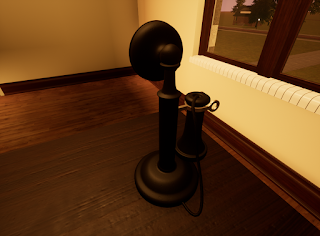I ended up using a slightly different method when it came down to connecting nodes in the materials editor, but he explains it very well.
My versions are below. With the world aligned materials, the normals don't work correctly if the texture is facing the wrong way, so I had to make separate x-facing and y-facing versions. There is probably a way to do this within a single material, or through a material instance, but that is beyond my abilities for now. In these screenshots, the tile coves are two separate meshes: one for the long sections, and another for the corners. They line up perfectly because they have the same axis. The textures always line up because they use the same world aligned material as the adjacent wall. Also, I am able to use the same mesh for all of the long sections because the world aligned material automatically scales the texture properly. The wood wainscot sections all have to be separately scaled in Blender and imported because the wood material is not world aligned. These world aligned brick materials have saved be numerous hours in scaling and importing -- I just line up the axis of each tile cove, and they're done!
















